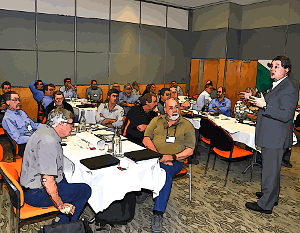On the day

When the presentation begins, it's time to forget about any distractions or issues that aren't relevant to the moment, and concentrate on the performance. Try to speak naturally and not too quickly. Take extra care to pronounce words clearly, and don't be afraid to pause when you make a strong point or use a key term or phrase.
Dealing with nerves
Different people have different phobias, but one of the most common is a fear of public speaking. Fortunately, this phobia is easily treatable in most people through 'desensitisation' - that is, progressively being exposed to the situation more and more, and building up the resilience to handle it.
If you're new to training and you suffer a lot from nerves, see if you can limit your presentations to smaller, less formal groups to start with, and as your confidence grows, gradually step up to the level you'll be expected to work at as a professional trainer.
It's also worth reminding yourself that feeling nervous before or during a presentation is perfectly natural. Many famous performers and actors have battled nerves throughout their careers, and some have said that this nervous energy is what gives their performances life and exuberance. So the best advice is: Don't try to fight it, learn to harness it.
However, there are various things you can do to reduce the level of anxiety you're suffering so that it doesn't take over and spoil your presentation. These include:
- practising and fine-tuning your delivery until you're happy with it
- planning and preparing everything in advance, so there is no last minute rush
- thinking positively about your abilities and your capacity to do a good job.
Body language
When you stand in front of a group to give a presentation, it's not just the words you use that carry meaning for the audience. Your body language will also be on display, and will either reinforce the message or detract from it.
Body language is all the non-verbal forms of communication that take place through your gestures, facial expressions and general demeanour. As a presenter, you should try to see yourself the way your audience sees you, and use your body language to project a sense of enthusiasm in the topic and a genuine interest in the participants.
You can do this by:
- establishing eye contact with participants
- avoiding distracting mannerisms
- smiling and looking like you are enjoying the event
- standing tall and maintaining a look of confidence.
You should also stay attuned to the non-verbal signals of your audience members. If they begin yawning or fidgeting, it could mean that they're getting bored. In that case, you could liven up the presentation by getting them involved in some way, or if it's a long presentation, give everyone a break. If people are frowning or looking puzzled, it might mean that you need to take more time to explain the topic you're covering.

